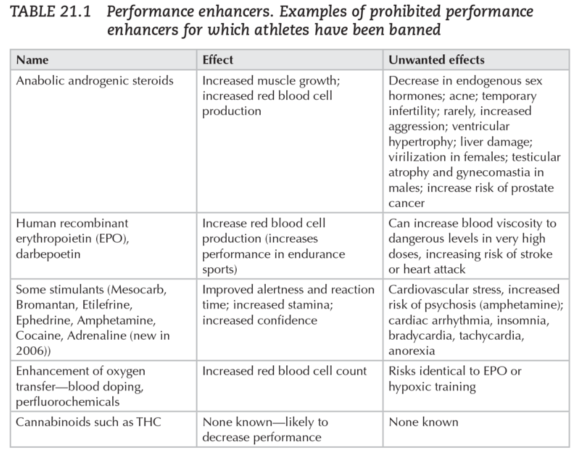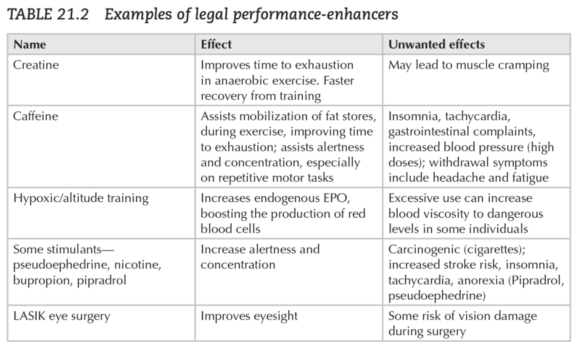Whatever we think that sport should or should not be, there is one good reason why the world’s sporting bodies are undertaking such a concerted effort to eliminate doping in elite sport. There is one good reason why there are no ’pro doping’ movements and no legal challenges to the laws against doping in sport. The reason is simply this: doping is currently the most widespread method of cheating. Professional athletes are cheating, and worse, they are using methods which quite often put their health at risk, as Table 21.1 illustrates.

These health risks give us good reasons to ban performance enhancing drugs. But not all harmful drugs are banned, and a number of banned drugs do not threaten athletes’ health. Is it possible that the sporting bodies are not worried, or not at least primarily worried, about health?
The World Anti-Doping Agency, which defines which drugs will be banned in international athletics, bans a drug if it has at least two out of three of the following criteria. First, it must have the potential to increase sporting performance. Second, it must represent an actual or potential risk to the athlete’s health, and third, its use must be contrary to the ’spirit of sport’, which they define in the same document (World Anti-Doping Agency, 2003b).
According to the Anti-Doping Agency’s definition, you are not doping if you are taking harmful drugs which do not enhance performance or violate the spirit of sport, such as tobacco (see Table 21.2). And you are not doping if you take performance-enhancing drugs which do not harm you or violate the spirit of sport. Under the current code, for example, caffeine is not illegal, even though it can strongly increase performance. In endurance sports, caffeine helps to mobilize the fat stores of an athlete (Costill, Dalsky & Fink, 1978). It can make as much as a 20% difference in the time to exhaustion among competitive athletes. That is a massive difference. Dietary supplements such as creatine are also legal on this 2-out-of-3 rule, and they also strongly influences performance. Creatine is similar to the banned drug EPO - in that it supplements an endogenous substance. Two different double-blind studies found that the time to exhaustion in anaerobic exercise could be increased by over 10% by the use of creatine (Bosco et al., 1997; Prevost et al., 1997). But creatine, like caffeine, is legal because it is not thought to harm athletes or violate the spirit of sport.

However, the Code goes on to say explicitly that all ’[d]oping is fundamentally contrary to the spirit of sport’. In other words, if a drug is banned because it is both harmful and performance enhancing, it is necessarily considered to violate the spirit of sport as well. This statement contradicts the 2-out-of-3 rule because it adds this spirit-violating property to every banned group. Perhaps this is a mistake, but if it is not, then WADA and its supporters are not seriously worried about health risks. Neither are they seriously worried about performance enhancement. If either of these concerns were important to WADA, it would sometimes consider banning a drug just because it was harmful like tobacco or just because it was performance enhancing like creatine. In fact, the WADA code is functionally identical to a single-criterion code which defines doping as ’any substance or method which violates the spirit of sport’. This obsession with the spirit of sport is echoed in Pound’s rationale, quoted above.
So what is WADA’s conception of the spirit of sport?
WADA defines the ’spirit of sport’ using a long list of words (World Anti-Doping Agency, 2003a):
- Ethics, fair play and honesty
- Health
- Excellence in performance
- Character and education
- Fun and joy
- Teamwork
- Dedication and commitment
- Respect for rules and laws
- Respect for self and other participants
- Courage
- Community and solidarity.
This may be a good list of features that embody the aspirational ’spirit of sport’. But as a way to choose which drugs to ban, it is terrible.
Many of the terms on this list refer only to the amateur sport, not the elite sport where the anti-doping effort is focused. Fun and joy, for example, seem to be only a very weak requirement in elite sport. Similarly, elite athletes do not compete to improve their health or their education. Some of the terms on the list represent concepts that are not threatened by doping at all. For example, it is hard to see how teamwork is threatened by doping, especially when a whole team is doping. In one way, we might even think it courageous, dedicated or committed to take a harmful drug in the pursuit of sporting success, especially where that success also benefits one’s team. Finally, some of the terms on the list are not threatened if every athlete is doping or if doping is legal. Excellence in performance is only threatened by doping when doping is against the rules. If a drug is legal there is no threat to an athlete’s ’character’. And ’solidarity’ is not threatened in cycling, where we assume that almost every athlete is taking EPO or blood doping.
The only terms on the list that are threatened by doping are those concerned with cheating. ’Respect for rules and laws’ is at the heart of what motivates the crusade against doping. If we retain the WADA code, but cut away the irrelevant parts of their ’spirit of sport’, doping is just using a substance or a method which is against the rules of the sport. That is, doping is just cheating by using drugs.
And that is probably as good a definition of doping as we will get, but it begs the question - why do we need rules against these drugs and training methods? Cheating is bad for sport because a sport is defined by its rules, but eradicating doping is not the only way to eradicate drug cheats. The other way is just to erase the anti-doping rules.